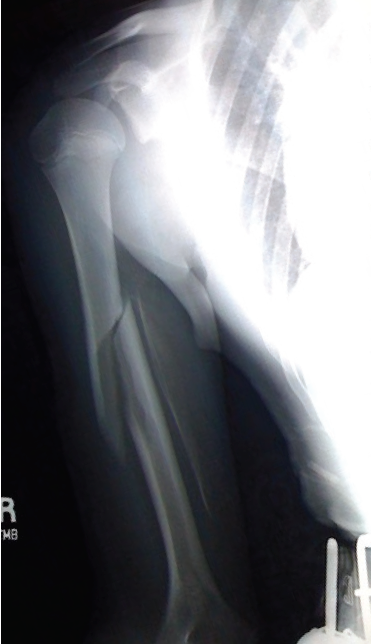A Fastball Followed by Excruciating Arm Pain
A 13-year-old boy presented to urgent care 90 minutes after having pitched in a Little League baseball game. His main complaint was acute right arm pain, which had occurred during the release of his 14th pitch of the game, a fastball. He described the pain as being 10 of 10 in intensity and being located in the midhumeral region without radiation. He reported that the pain was throbbing and deep in character, aggravated with movement, and only minimally relieved with rest. He denied numbness or paresthesia.

The patient had no significant past medical or surgical history other than a fifth right phalanx fracture from a fall. His family history included a 5-year-old sister who had had a compound fracture of the radius and ulna from a 2-foot fall; his father had had a clavicular fracture from playing football. The patient did not use alcohol, tobacco, or illicit or performance-enhancing drugs. The review of systems was unremarkable.
Physical examination was unremarkable, except for the right upper extremity. The right arm was noted to be swollen compared with the left arm. The patient had tenderness to palpation over the anterior and posterior aspect of the right arm. The right elbow had normal flexion and extension, but the patient was unable to move his right shoulder because of severe pain, which limited the examination. No wrist drop was noted. The patient had normal radial pulse and normal sensation of the right arm.
Plain radiographs led to the diagnosis.
What is the cause of this boy’s acute arm pain?
(Answer and discussion on next page)
ANSWER: Ball-thrower’s fracture
The radiographs revealed ball-thrower’s fracture—an oblique fracture of the right midhumeral shaft, displaced posteriorly and medially.

Baseball pitchers frequently sustain injuries such as humeral labral tears, Little League elbow (medial epicondyle apophysitis), and proximal humeral epiphysitis; nontraumatic fractures among pitchers, however, are rare. Ball-thrower’s fracture, first described in 1895, is a humeral fracture resulting from muscular action and angular rotation in the absence of obvious trauma.
Humeral fractures in pitchers most often result from trauma. The intense torsion on the humerus during the act of throwing a ball with extreme force can generate enough stress to cause an acute fracture.1 (Our 13-year-old patient, for example, could consistently throw a 70-mile-per-hour fastball.) The fracture can occur during any point of the acceleration phase of the throwing cycle.2
Ball-thrower’s fracture has been reported in throwers of such diverse objects as hand grenades, stones, and javelins; it is uncommon among trained and seasoned athletes and is more often seen in recreational and younger baseball players.2 The altered shoulder biomechanics and cortical hypertrophy from years of training is thought to be protective and thus decrease the occurrence rate of ball-thrower’s fracture in older and trained athletes.2 Other risk factors include repetitive stress and lack of regular throwing-motion exercise.3
The mechanism of injury is not fully understood. The injury commonly occurs during the moment of a full-intensity throw and often is accompanied by an audible crack or snap.4 The sheer torque force and strain on the humerus during the acceleration phase of the throwing motion place the bone in a state of maximal external rotation at the moment when humeral torque force is at its peak, thereby causing the acute fracture. It also is possible that damage to either the inferior glenohumeral ligament or coracohumeral ligament produces greater external rotation, resulting in increased torsional strain.5
In the past, oppositional forces applied by the brachialis and deltoid muscles also had been thought to be a primary cause of humeral fracture in pitchers; however, this theory does not explain the occurrence of distal humeral fractures.
The most common presentation of ball-thrower’s fracture is very sudden acute pain in the upper extremity during throwing. Unlike injuries to the lower extremity, no reliable clinical guidelines are available to recommend which patients require imaging. A thorough, detailed history of the precipitating event and a thorough physical examination are of utmost importance. The differential diagnosis should include brachial plexus injury, shoulder bursitis, impingement syndrome, rotator cuff injury, and humeral labral injury.
Treatment of ball-thrower’s fracture typically is nonoperative. The humeral fracture is immobilized for 10 to 14 days with a long-arm splint from the shoulder to the wrist or with casting. The rate of union is high with nonoperative therapy; there is a risk of mild malunion, however. Surgery is indicated when evidence of radial nerve damage, unacceptable malunion, multiple trauma, or open fracture is present.
Acute arm pain has many possible diagnoses, but acute arm pain occurring during a throwing motion should alert to the possibility of a ball-thrower’s fracture. Clinical suspicion and plain radiographs are diagnostic for this condition.
REFERENCES:
1. Inal S, Atik A, Er MS, et al. Ball-Thrower’s Fracture of the humerus: report of seven cases in soldiers following the throwing of hand grenades. Internet J Orthop Surg. 2009;12;1. doi:10.5580/f21.
2. Ogawa K, Yoshida A. Throwing fracture of the humeral shaft: an analysis of 90 patients. Am J Sports Med. 1998;26(2):242-246.
3. Soeda T, Nakagawa Y, Suzuki T, Nakamura T. Recurrent throwing fracture of the humerus in a baseball player: case report and review of the literature. Am J Sports Med. 2002;30(6):900-902.
4. Colapinto MN, Schemitsch EH, Wu L. Ball-thrower’s fracture of the humerus. CMAJ. 2006;175(1):31.
5. Sabick MB, Torry MR, Kim YK, Hawkins RJ. Humeral torque in professional baseball pitchers. Am J Sports Med. 2004;32(4):892-898.


